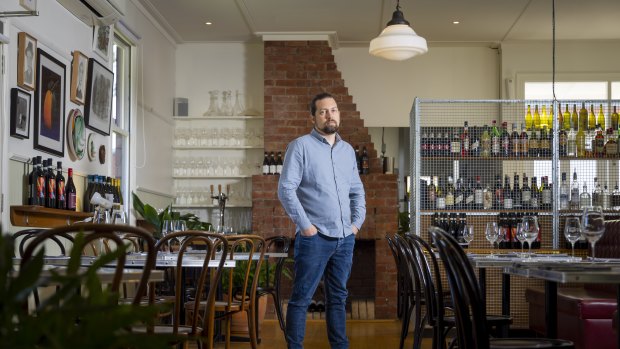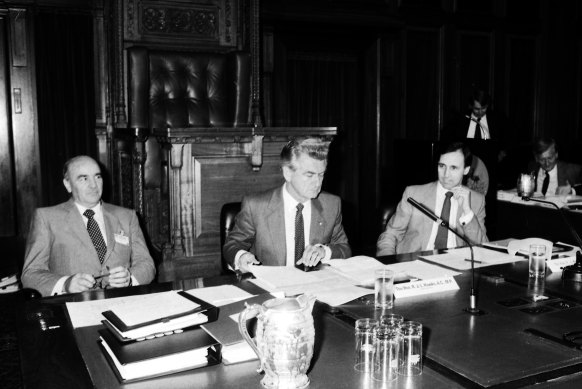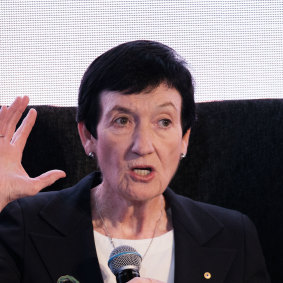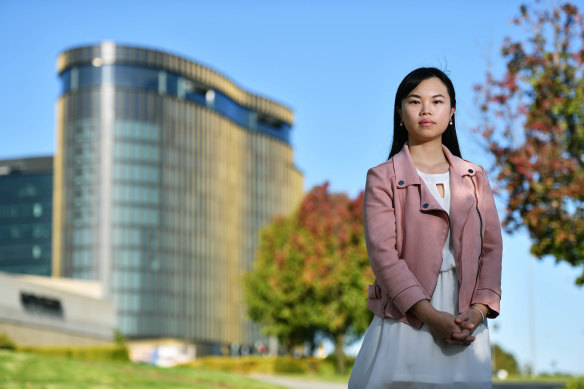This was published 2 years ago
Wages, migrants and the lack of workers is a delicate balancing act
By Ben Schneiders and Josh Gordon
Before the pandemic, Clinton Trevisi would get up to 70 applicants for a sous chef or assistant management role at his Melbourne CBD and Mornington Peninsula restaurants. Now, he is lucky to get just one applicant for a job that pays up to $80,000 a year.
“You’re lucky if you even get a bite, an actual application,” Trevisi says. It is even difficult to get people to turn up for a paid trial – barely 20 per cent do so, he says.

Clinton Trevisi is a restaurant owner who has struggled to find staff.Credit: Wayne Taylor
The staff shortages are particularly acute at his regional outfits – Bistro Elba in Sorrento and Donna Maria in Flinders – where at times this year, he’s had to cut back on lunchtime service or close for a few days a week.
“We definitely still restrict bookings to a manageable level because we need to operate within capacity,” he says. “You can’t afford for people to have a bad experience.”
Labor’s jobs summit, to be held in Canberra over the first two days of September, is coming at a historic juncture for the labour market. Not that many years ago, Australia’s problem was an excess supply of workers. The migration system was taking in hundreds of thousands of workers a year, not only through the skilled migration program but also through the largely unskilled student and working holiday visa streams.
In 2019, Australia had nearly 1 million temporary migrants – a dramatic shift from the post-war period when migration was almost entirely permanent. The temporary migrants included 652,000 international students with work rights, along with about 140,000 working holiday-makers and a further 120,000 temporary skilled visa holders.
The shift began in the 1990s, accelerating during the Howard era, spawning a dizzying array of visas as universities tried to boost funding through international student fees, and employers sought to tap a ready-made pool of international workers. It created, in effect, a guest worker program for skilled and unskilled foreign workers. The Fair Work Ombudsman has identified wage underpayment of these migrants as a major problem.
Now the problem has been flipped around. There are 500,000 fewer temporary migrants here than before the pandemic. It is unclear how many will return, and that is part of the reason for crippling labour shortages from sectors as diverse as cafes to shops and home removalists.
The key question at the summit is how to grow wages fast enough to at least maintain living standards while making long-term decisions about what Australia’s migration system will look like: how much of it will be permanent or temporary and how will this country train local workers to fill the gaps.
It is an extraordinarily challenging set of circumstances to juggle for a new government. If it fails to get the balance right, then living standards, jobs and the economy could all suffer.
Federal Treasury, which has been overly optimistic with its wage predictions for years, is now blaming the industrial landscape for low wages growth. In a discussion paper ahead of the summit, it warned that the immigration system had become overly complex and might no longer be delivering on its objectives to grow the population and meet Australia’s labour needs.
It also said there were “significant barriers” in industrial relations, including far fewer enterprise agreements being struck, which have tipped the scales against pay rises that go beyond inflation. There were also concerns about wage theft and the impact of labour hire, casual, rolling fixed term and gig economy work.
Wage theft and underpayment has been an issue for years. The Fair Work Ombudsman recovered $532 million in unpaid wages and entitlements last financial year – 17 times more than five years earlier. It is likely still just a fraction of the wage theft in the labour market. Pre-pandemic academic research, including by Laurie Berg and Bassina Farbenblum, suggests nearly half of all student and working holiday visa workers have been underpaid while in Australia.
Talk to many businesses, and they’ll say a shortage of workers is now their No. 1 problem. It is not only a lack of skilled workers but relatively unskilled workers, too. According to Treasury, there is now only one unemployed person per job vacancy, compared with three before the pandemic.
Talk to unions, and they’ll tell you the industrial system is badly broken. While they accept that there are genuine labour shortages, they argue that Australia’s economic gains over the past decade are no longer being shared in the form of higher wages as they once were.
The last time we had a summit like this was Bob Hawke’s national economic summit in 1983. Against a backdrop of spiralling wages growth and industrial unrest, the aim then was to bring together political parties, unions and business representatives to strike a national consensus on economic reform.
Over the following 13 years, the Hawke and Keating governments transformed the Australian economy through trade liberalisation, privatisation, deregulation and trade-offs between unions and the government. It led to significant social and economic reforms but also wage restraint and, in the 1980s, reductions in real wages. Australia became significantly wealthier in the intervening years, but also less equal, according to widely used measures of income inequality.

Bob Hawke (centre) and Paul Keating (right) at the national economic summit in Canberra in 1983.Credit: Fairfax
Forty years later, the benefits that flowed from the Hawke summit are long since exhausted. Real wages have failed to grow over the past decade, productivity growth is flagging, inflation is surging, and interest rates are rising at the fastest pace for many years.
Unions, meanwhile, are at a historic low point. Just 14 per cent of the workforce is unionised, compared with about half in the 1980s. Company profits now make up 31 per cent of total earnings from the production of goods and services, a post-war high, while wages make up about half, the lowest since the late 1950s.
The agenda for the summit is ambitious. It will canvas the women’s pay gap, migration, skills, future industries, workplace participation and industrial relations.
Finding consensus on some of these issues should be achievable but in other areas, the differences are near-intractable – particularly when it comes to industrial relations, where unions want a significant overhaul including industry-wide and multi-employer bargaining, which has already run into employer opposition.
The positions of unions and employer groups on many issues have ossified after decades of conflict. Employers are ascendant and many of the things that unions want to change, such as giving them a bigger role in negotiating industrial agreements, are bitterly opposed.
Unlike the lead-up to Hawke’s 1983 summit, this time the problem is not an excess of wages growth, but too little. In fact, real wages – measuring the buying power of our pay packets after factoring in the rising cost of living – have gone backwards over the past decade. According to the latest figures, over the year to June, as inflation surged, real wages fell by about 3.3 per cent, the largest decline on record.
The failure of the jobs market to generate wage gains has left the federal government’s forecasters flummoxed for years. In a speech to the Economic Society of Australia, Reserve Bank governor Philip Lowe last year argued that “tighter labour markets do generate stronger wage increases”.
“The laws of supply and demand still work,” he said, almost wistfully.
Or do they?
Business groups such as the Business Council of Australia, which says it wants to work with unions to identify genuine solutions to Australia’s problems, say the summit is a chance to lay the groundwork for sustained wages growth “fuelled by productivity”. But they are also warning that the worst outcome would be if Australia returns to a situation where wages are rising too quickly without being underpinned by productivity improvements. What that means exactly is in the eye of the beholder. Productivity gains can be made either by making workers produce more each hour they work, or through better technology (or a combination).
Unions point out that wages are nowhere near keeping pace with cost-of-living pressures, while insecure work remains rife.
All the while, key sectors such as health, education, transport, logistics, agriculture and hospitality have come close to buckling as they continue to deal with the impact of the pandemic.
Unions claim that the economy needs to focus on better training, more secure work, more permanent rather than temporary migration, better regulation of workplaces and higher wages. Permanent migration was reduced to 160,000 people a year by the former Coalition government, and Labor has signalled increasing that to 180,000 to 200,000 people a year.
The Australian Council of Trade Unions, in one of a series of reports published ahead of the summit, said its support for any increase in permanent migration was conditional on significant changes that would boost wages across the economy, including an overhaul of workplace laws.
ACTU president Michele O’Neil said this would include significant changes to the Fair Work Act. “The most obvious example is fixing our bargaining system. If we are going to lift wages, we are going to need to fix it.”

ACTU president Michele O’Neil.Credit: Alex Ellinghausen
According to Treasury, just 35.1 per cent of employees are covered by enterprise agreements, compared with 43.4 per cent in 2010. The number of workers on the minimum wage of awards has soared by more than 1 million in that time. As many as 250,000 workers are estimated to be paid in the so-called “gig economy”, with a lack of employment conditions.
The ACTU wants skilled visa conditions that tie workers to a single employer to be abolished, saying the migrants would be tied to an industry instead. “Allowing an employer to control your pay cheque and passport is a recipe for exploitation,” O’Neil says.
She also wants to make a clear “self-nominated” path for temporary migrants to obtain permanent residency and to be able to access social security, including Centrelink and Medicare – potentially significant changes.
The business council’s Jennifer Westacott says the summit must agree on the role of well-managed skilled migration as a key driver of Australia’s prosperity.
“We need to move from a short-term, ad hoc system to long-term planned migration with a focus on four-year visas, pathways to permanent migration and future planning of our population growth so we get the housing, transport and health services right,” she says.

BCA chief executive Jennifer Westacott.Credit: Oscar Colman
“We want to see a catch-up boost to the permanent migration program, with at least two-thirds of places for skilled workers. And, in the very near term, we must address the backlog of visa approvals across all categories because we simply don’t have enough people to do things.”
Westacott also says that Australia will need to focus on future industries such as renewable energy to drive real wages growth, with a big focus on technology, skills and productivity.
University of Melbourne law professor Joo-Cheong Tham says there is a need for an overhaul, including making union membership a default in industries beset by wage theft. “Migrant workers can still opt out. The reality in many poorly regulated industries is that they are de facto union-hostile workplaces,” he says.
“The pandemic gives an opportunity in terms of a reset for the temporary migrant system. It’s been dysfunctional and exploitative for many years.
“The problem of exploitation is happening in industries where exploitation is already the norm,” says Professor Tham, citing hospitality, cleaning services, food delivery and agriculture in particular.
The Grattan Institute’s economic policy program director, Brendan Coates, says only increasing permanent migration would not solve labour shortages. “It’s kind of like chasing your own tail,” he says, because migrants themselves add to labour demand while the majority of permanent migrants are already here as temporary workers. The main benefit is to federal and state budgets.
Coates says the priority should be “higher skill and wage” temporary visa holders. The issue of student visa holders is particularly fraught, and the pandemic-era changes to lift a previous requirement to limit their work to 20 hours a week risks turning student visas even more into a “de facto low-skilled work visa”, he says.
The big issue is not so much the students at major universities but the plethora of private training colleges “where it’s not clear what the value of the education experience is”, Coates says. “It seems people are buying a visa and using that to then work under the table in Australia.”
Employers and unions alike say the exclusion of temporary migrant workers from JobKeeper has damaged Australia’s reputation. Then-prime minister Scott Morrison even told them to “go home” in early 2020. The number of temporary migrants is still far lower than it was three years ago.
Eva Su, from Taiwan, was here at the start of the pandemic on a 12-month working holiday visa and witnessed the upheaval first-hand while losing her job at a five-star hotel. “A lot of my friends at the time just went back home,” she says.
In April 2020, The Age interviewed Su and other temporary migrant workers about being “starved” out of the country. At the time, she was on the brink of leaving because she had nearly run out of money.
But she was one of the lucky ones. She received help after the article was published, allowing her to stay. “It was really moving. I received lots of emails and text messages, including from second-generation migrants who wanted to help. That was amazing.”
She also got assistance from charities for food and support, and her family in Taiwan helped out. “I decided to stay and get a degree.”
She is now working at News Corp in a graduate program in consumer/digital marketing. “I just graduated this year and I’m going to apply for a postgraduate work visa at the end of this year.”

Working holiday visa holder Eva Su has witnessed the upheaval in the jobs market first-hand.Credit: Joe Armao
Clinton Trevisi is looking ahead to the busy summer season at his restaurants with some apprehension.
“It’s never been this hard before, staffing-wise … as a small business owner, you are used to having control over what you do and can make your own success and failures.”
In an industry where wage theft has been common, Trevisi says he has always paid above award. “I’ve got no issue with the minimum wage going up. I think that needs to happen.”
But in an environment of labour shortages, wage demands are now rising. “Some of the wage expectations are far out of reach,” he says. “We’ve all accumulated debts over the lockdowns and over the last couple of years, and you want to make the money back. There is that restriction on how quick that can happen because of the lack of a labour force.”